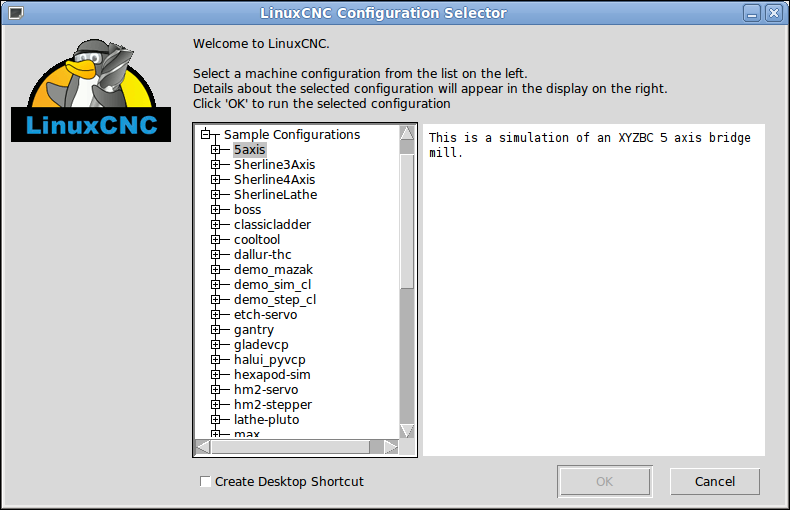1. 调用LinuxCNC
安装后,LinuxCNC就像其他任何Linux程序一样启动: 在 终端通过运行命令'linuxcnc'运行, 或在菜单“应用程序-CNC”中选择。
2. 配置启动器
当从CNC菜单或命令行启动LinuxCNC而未指定ini文件时,将启动“配置选择器”对话框。
The Configuration Selector dialog allows the user to pick one of their existing configurations (My Configurations) or select a new one (from the Sample Configurations) to be copied to their home directory. Copied configurations will appear under My Configurations on the next invocation of the Configuration Selector. 使用“配置选择器”对话框,用户可以选择一个现有配置(“我的配置”)或选择一个新配置(从“示例配置”中复制到其主目录)。 下次调用配置选择器时,复制的配置将显示在“我的配置”下。
The Configuration Selector offers a selection of configurations organized: 配置选择器提供了以下组织的配置选择:
-
“我的配置”-用户配置位于~/linuxcnc/configs中
-
Sample Configurations - Sample configurations, when selected are copied to /linuxcnc/configs. Once you copy a sample configuration if you use the launcher pick it from My Configurations “示例配置”-选择示例配置后,将其复制到/linuxcnc/configs。 复制示例配置(如果使用启动器)后,请从“我的配置”中进行选择
-
sim - Configurations that include simulated hardware. These can be used for testing or learning how LinuxCNC works. “sim”-包含硬件模拟的配置。这些可用于测试或了解LinuxCNC的工作方式。
-
by_interface - Configurations organized by GUI. “by_interface”-由GUI组织的配置。
-
by_machine - Configurations organized by machine. “by_machine”-按机器组织的配置。
-
apps - Applications that do not require starting linuxcnc but may be useful for testing or trying applications like PyVCP or GladeVCP. “apps”-不需要启动linuxcnc,但对测试或尝试 PyVCP 或 GladeVCP之类的应用程序可能有用的应用程序。
-
attic - Obsolete or historical configurations. “attic”-过时或历史配置。
-
The sim configurations are often the most useful starting point for new users and are organized around supported guis: 对新用户而言,“sim”配置通常是最有用的入门,并且围绕受支持的图形界面进行规划:
-
axis - Keyboard and Mouse Gui 轴-键盘和鼠标Gui
-
gmoccapy - Touch Screen Gui gmoccapy-触摸屏Gui
-
gscreen - Touch Screen Gui gscreen-触摸屏Gui
-
low_graphics - Keyboard Gui low_graphics-键盘Gui
-
tklinuxcnc - Keyboard and Mouse Gui(no longer maintained) tklinuxcnc-键盘和鼠标Gui(不再维护)
-
touchy - Touch Screen Gui touchy-触摸屏Gui
A gui configuration directory may contain subdirectories with configurations that illustrate special situations or the embedding of other applications. 图形界面配置目录可能包含子目录,这些子目录的配置说明了特殊情况或其他应用程序的嵌入。
The by_interface configurations are organized around common, supported interfaces like: by_interface配置围绕常见的受支持接口进行组织,例如:
-
general mechatronics
-
mesa
-
parport
-
pico
-
pluto
-
servotogo
-
vigilant
-
vitalsystems
Related hardware may be required to use these configurations as starting points for a system. 可能需要相关的硬件才能将这些配置用作系统的起点。
The by_machine configurations are organized around complete, known systems like: by_machine配置围绕完整的已知系统进行组织,例如:
-
boss
-
cooltool
-
sherline
-
smithy
-
tormach
A complete system may be required to use these configurations. 使用这些配置可能需要一个完整的系统。
The apps items are typically 1) utilities that don’t require starting linuxcnc or 2) demonstrations of applications that can be used with linuxcnc: 应用项目通常是1)不需要启动linuxcnc的实用程序或2)可以与linuxcnc一起使用的应用程序的演示:
-
info - creates a file with system information that may be useful for problem diagnosis. 创建包含系统信息的文件,该文件可能对问题诊断很有用。
-
gladevcp - Example gladevcp applications. 示例glaevevcp应用程序。
-
halrun - Starts halrun in a terminal. 在 终端中启动halrun。
-
latency - Applications to investigate latency 测试延迟的应用程序
-
latency-test - standard test 标准测试
-
latency-plot - stripchart 带状图
-
latency-histogram - histogram 直方图
-
-
parport - Applications to test parport. 应用程序测试parport。
-
pyvcp - Example pyvcp applications. 示例pyvcp应用程序。
-
xhc-hb04 - Applications to test an xhc-hb04 USB wireless MPG 测试xhc-hb04 USB无线MPG的应用程序
[NOTE] 注意 Under the Apps directory, only applications that are usefully modified by the user are offered for copying to the user’s directory. 在应用程序目录下,仅提供经用户有用修改的应用程序才能复制到用户目录。
Click any of the listed configurations to display specific information about it. Double-click a configuration or click OK to start the configuration. Select Create Desktop Shortcut and then click OK to add an icon on the Ubuntu desktop to directly launch this configuration without showing the Configuration Selector screen. 单击任何列出的配置以显示有关它的特定信息。 双击配置或单击“确定”以启动配置。 选择“创建桌面快捷方式”, 然后单击“确定”在Ubuntu桌面上添加图标以直接启动此配置, 而不显示“配置选择器”屏幕。
When you select a configuration from the Sample Configurations section, it will automaticly place a copy of that config in the linuxcnc/configs directory. 当从“示例配置”选择配置时,它将自动将该配置的副本放置在linuxcnc/configs目录下。
3. Next steps in configuration 配置的后续步骤
After finding the sample configuration that uses the same interface hardware as your machine (or a simulator configuration), and saving a copy to your home directory, you can customize it according to the details of your machine. Refer to the Integrator Manual for topics on configuration. 找到使用与计算机相同的接口硬件的示例配置(或模拟器配置), 并将副本保存到主目录后,您可以根据计算机的具体信息对其进行自定义。 有关配置的主题,请参阅《集成商手册》。
4. Simulator Configurations 模拟器配置
All configurations listed under Sample Configurations/sim are intended to run on any computer. No specific hardware is required and real-time support is not needed.
Configurations/sim下列出的所有配置均可在任何计算机上运行。 不需要特定的硬件,也不需要实时支持。
These configurations are useful for studying indivdual capabilities or options. The sim configurations are organized according to the graphical user interface used in the demonstration. The directory for axis contains the most choices and subdirectories because it is the most tested GUI. The capabilities demonstrated with any specific GUI may be available in other GUIs as well. 这些配置对于研究独立功能或选项很有用。sim配置根据演示中使用的图形用户界面进行适配。 axis的目录包含最多的选择和子目录,因为它是经过最多测试的图形界面。 任何特定图形界面演示的功能也可以在其他图形界面中使用。
5. Configuration Resources配置资源
The Configuration Selector copies all files needed for a configuration to a new subdirectory of /linuxcnc/configs (equivalently: /home/username/linuxcnc/configs). Each created directory will include at least one ini file (iniflename.ini) that is used to describe a specific configuration. 配置选择器将配置所需的所有文件复制到/linuxcnc/configs的新子目录(等效于:/home/username/linuxcnc/configs)。 每个创建的目录将至少包含一个ini文件(iniflename.ini),该文件用于描述特定的配置。
File resources within the copied directroy will typically include one or more ini file (filename.ini) for related configurations and a tool table file (toolfilename.tbl). Additionally, resources may include halfiles (filename.hal, filename.tcl), a README file for describing the directory, and configuration specific information in a text file named after a specific configuration (inifilename.txt). That latter two files are displayed when using the Configuration Selector. 复制的目录中的文件资源通常包括一个或多个用于相关配置的ini文件(filename.ini) 和一个工具表文件(toolfilename.tbl)。 另外,资源可能包括hal文件(filename.hal,filename.tcl),用于描述目录的自述文件, 以及以特定配置命名的文本文件(inifilename.txt)中的特定配置信息。 使用配置选择器时,将显示后两个文件。
The supplied sample configurations may specify HALFILEs in the configuration ini file that are not present in the copied directory because they are found in the system Halfile library. These files can be copied to the user configuration directory and altered as required by the user for modification or test. Since the user configuration directory is searched first when finding Halfiles, local modifications will then prevail. 提供的示例配置可能会在配置ini文件中指定在复制的目录中不存在的HALFILE, 因为它们是在系统Halfile库中找到的。这些文件可以复制到用户配置目录, 并可以根据用户的要求进行更改以进行修改或测试。 由于在查找Halfile时会首先搜索用户配置目录,因此将以本地修改为准。
The Configuration selector makes a symbolic link in the user configuration directory (named hallib) that points to the system Halfile library. This link simplifies copying a library file. For example, to copy the library core_sim.hal file in order to make local modifications: 配置选择器在用户配置目录(名为hallib)中建立指向系统Halfile库的符号链接。 该链接简化了库文件的复制。例如,复制库core_sim.hal文件以进行本地修改:
cd ~/linuxcnc/configs/name_of_configuration
cp hallib/core_sim.hal core_sim.hal